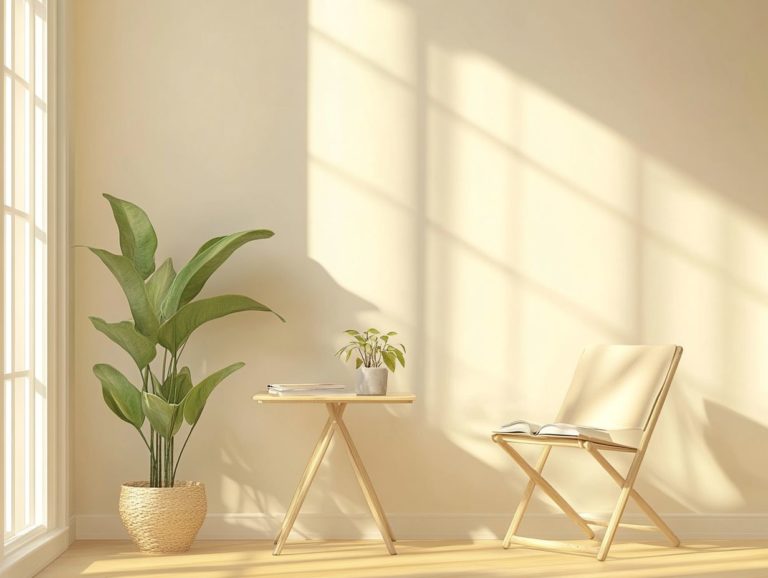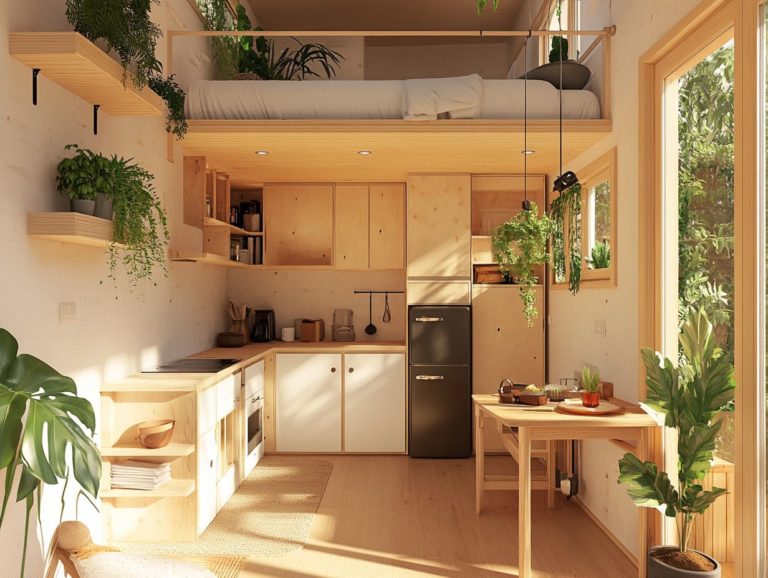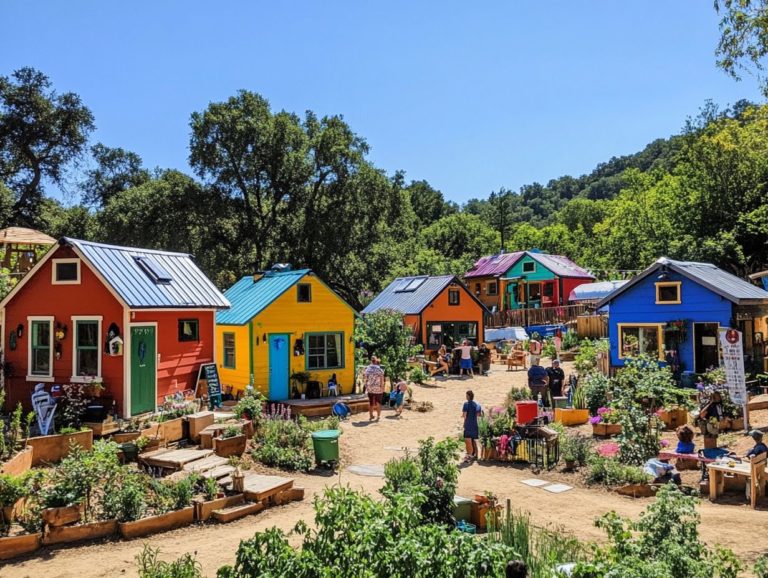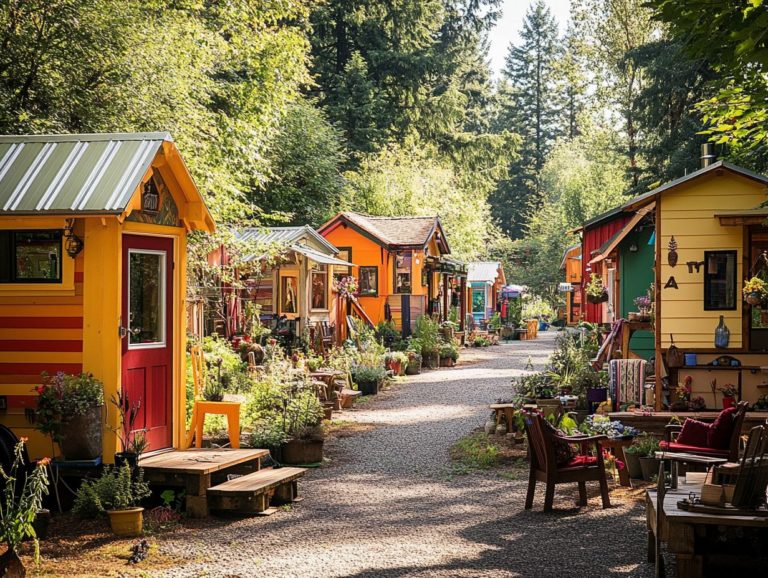8 Ways to Make Your Tiny House Eco-Friendly
In a world where environmental awareness reigns supreme, tiny houses have emerged as a compelling solution for sustainable living. These compact dwellings help you reduce your impact on the environment and encourage a simpler, more intentional lifestyle.
This article delves into eight practical ways to make your tiny house eco-friendly, covering everything from sustainable building materials to harnessing solar power. It also examines the benefits and challenges of tiny house living and offers insights on how to seamlessly incorporate eco-friendly practices into your daily routine.
Discover the transformative potential of tiny living for both yourself and the planet as you embark on this enlightening journey.
Contents [hide]
- Key Takeaways:
- 1. Use Sustainable Building Materials
- 2. Install Energy-Efficient Appliances and Fixtures
- 3. Incorporate Natural Lighting and Ventilation
- 4. Implement a Rainwater Harvesting System
- 5. Utilize Solar Power
- 6. Compost and Recycle
- 7. Choose Low-Impact Landscaping
- 8. Minimize Water Usage
- Why Choose a Tiny House for a Greener Life?
- What Are the Benefits of Living in a Tiny House?
- What Are the Challenges of Building an Eco-Friendly Tiny House?
- How Can One Incorporate Sustainable Practices into Their Daily Routine?
- What Are the Long-Term Savings of Living in an Eco-Friendly Tiny House?
- What Are Some Common Misconceptions About Tiny Houses and Sustainability?
- Frequently Asked Questions
Key Takeaways:
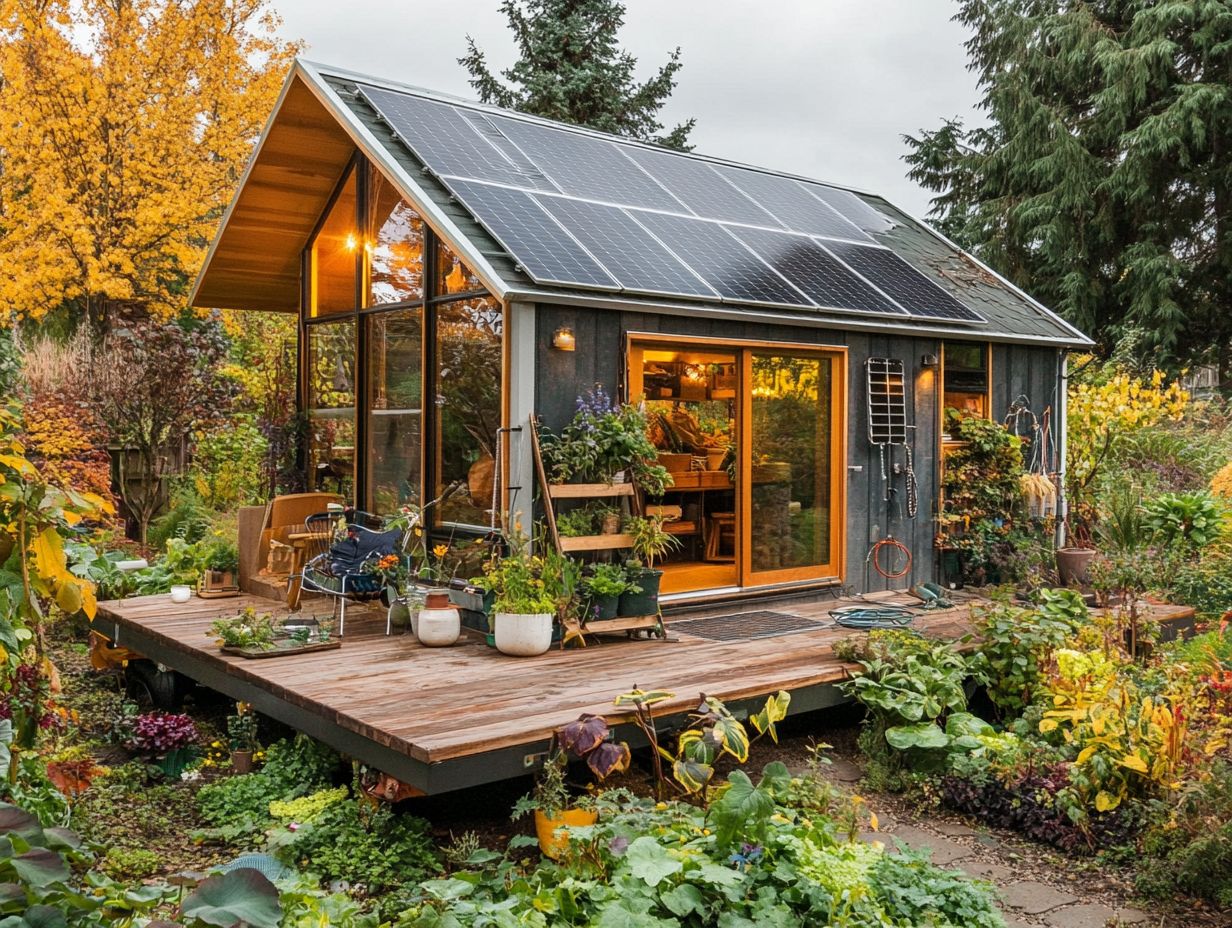
- Choose materials that are sustainable to reduce environmental impact and promote longevity in your tiny house.
- Use energy-efficient appliances and fixtures to save energy and resources.
- Maximize natural lighting and ventilation to reduce energy consumption and create a healthier living space.
1. Use Sustainable Building Materials
In the world of tiny homes, your choice of sustainable building materials plays a vital role in reducing your impact on the environment and embracing a waste-free lifestyle. It s about striking a perfect balance between comfort and responsibility.
Opt for eco-friendly materials like bamboo, reclaimed wood, and cork. These choices create a space that s visually appealing and aligned with sustainable building practices.
Sourcing these materials from local sawmills supports your community and cuts down on transportation emissions, boosting the sustainability of your building process. Companies that champion eco-friendly practices, such as Tru Form, are crucial to this movement, providing a variety of materials that meet rigorous sustainable standards.
Bamboo grows quickly and offers impressive strength, making it an excellent choice for structural elements. Reclaimed wood adds unique character while keeping valuable materials out of landfills. Cork offers fantastic thermal properties for insulation, ensuring your tiny home stays energy-efficient year-round.
This exciting approach is key for anyone eager to live sustainably.
2. Install Energy-Efficient Appliances and Fixtures
Installing energy-efficient appliances and fixtures is crucial for your tiny home. They help reduce energy consumption and promote a sustainable lifestyle that aligns with eco-friendly principles.
Choose modern appliances like ENERGY STAR-rated refrigerators, compact washers, and dryers that consume significantly less power and water compared to traditional models. Incorporating LED lighting offers bright, long-lasting illumination while cutting down your electricity bills.
Low-flow fixtures, such as showerheads and faucets, bolster your water conservation efforts. Integrating smart home technology helps you monitor your energy use and make automated adjustments for optimal savings without sacrificing comfort.
3. Incorporate Natural Lighting and Ventilation
Incorporating natural lighting and ventilation into your tiny home enhances its aesthetic appeal and energy efficiency. This reduces reliance on artificial lighting and heating systems.
This integration greatly enhances your living environment by improving air quality and creating a more inviting atmosphere. By opting for larger windows and strategically placed skylights, you embrace sunlight and fresh air, transforming your space into a bright haven.
Choosing the right insulation options ensures you enjoy these natural elements while maintaining optimal temperature control and energy savings. This focus on comfort and efficiency makes tiny homes delightful sanctuaries for you and your loved ones.
Join the tiny house movement today and make a difference!
4. Implement a Rainwater Harvesting System
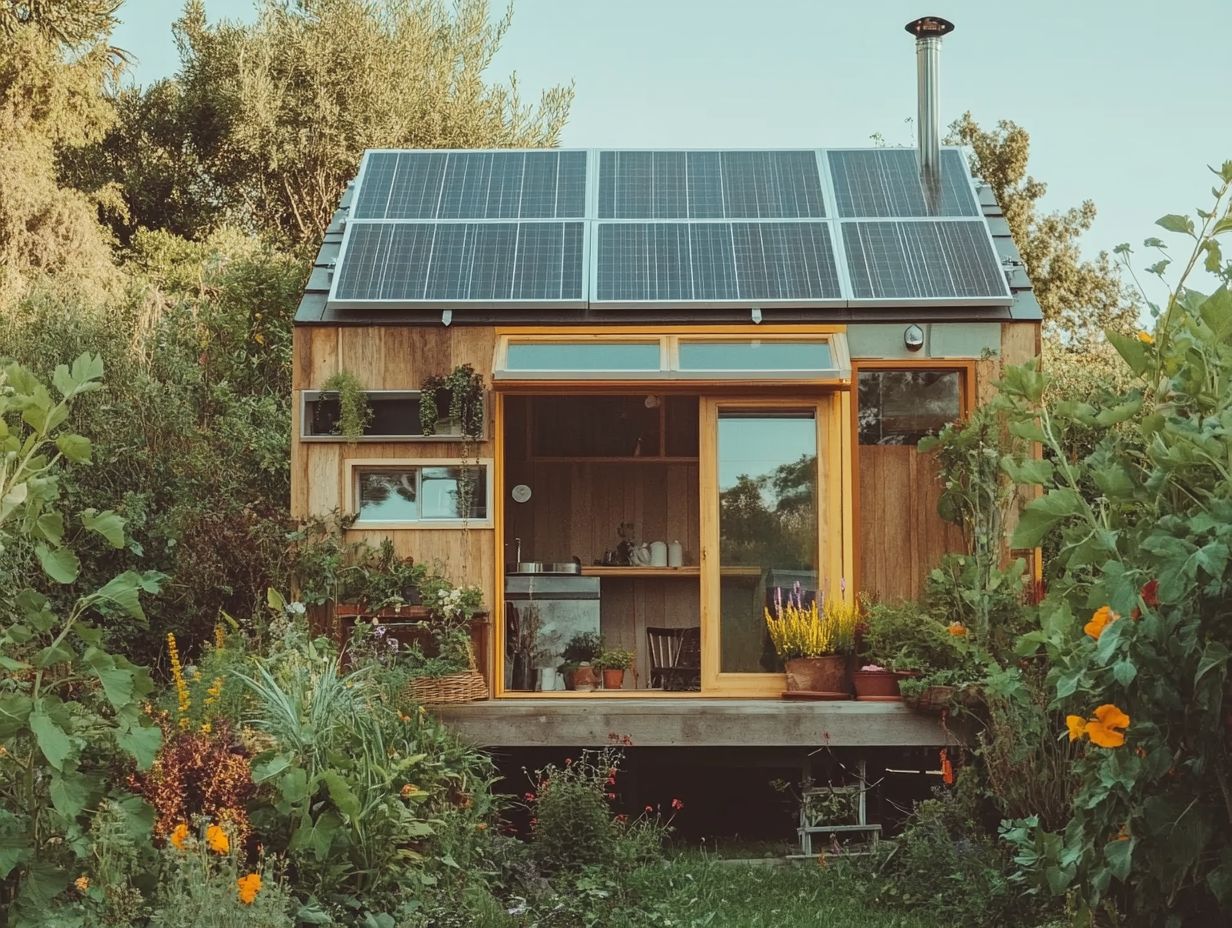
Implementing a rainwater harvesting system in your tiny home is a brilliant way to cultivate sustainability. This helps conserve water and reduce reliance on municipal systems, promoting an eco-friendly lifestyle you can truly be proud of.
These systems capture and store rainwater from your rooftop. You can harness natural precipitation for uses like irrigation, toilet flushing, and even laundry. You can also recycle water from sinks and showers, enriching your water management. This dual approach maximizes water efficiency and minimizes waste, creating a circular water economy right in your home.
As climate change escalates and water scarcity looms as a critical issue, adopting these technologies enables you to contribute to a more sustainable way of living. You ll ensure that water resources are used wisely and preserved for the generations yet to come.
5. Utilize Solar Power
Utilizing solar power by installing solar panels is a transformative leap for your tiny home. This sustainable energy source significantly cuts down on your energy costs and carbon emissions.
Using solar energy improves your home’s ecological footprint and overall design. There are various solar panel options available, including monocrystalline, polycrystalline, and thin-film varieties, each tailored to fit your specific tiny home setup.
The installation process is typically straightforward, requiring minimal space. Panels allow for seamless integration into your rooftop or awning. By harnessing solar energy, you can enjoy substantial long-term savings on electricity bills while embracing a self-sufficient lifestyle that beautifully aligns with nature.
6. Compost and Recycle
Implementing composting systems and recycling practices within your tiny home is essential for achieving a waste-free lifestyle. By doing so, you can significantly reduce household waste and actively promote sustainability.
Embracing these innovative approaches minimizes your environmental footprint while fostering a lifestyle that resonates with nature. Take composting toilets, for example; they transform human waste into nutrient-rich compost, effectively reintroducing valuable resources back into the ecosystem.
This practice not only eases pressure on sewage systems but also champions responsible waste management. It shows how even the smallest living spaces can contribute meaningfully to a larger circular economy.
As you adopt these practices, you play a crucial role in reducing landfill waste. Ultimately, you nurture a healthier planet for generations to come.
7. Choose Low-Impact Landscaping
Opting for low-impact landscaping options for your tiny home elevates its aesthetic charm while nurturing local ecosystems. This fosters biodiversity in an environmentally conscious way.
By incorporating elements like green roofs, you can achieve insulation for your home while creating habitats for various wildlife. This choice encourages you to live in harmony with nature.
Establishing native plant gardens is equally essential; they require minimal water and maintenance while attracting essential pollinators. These practices ensure that your landscaping aligns seamlessly with the ethos of tiny home living.
This approach is truly rewarding, connecting you more deeply to your environment while helping to reduce your ecological footprint.
8. Minimize Water Usage
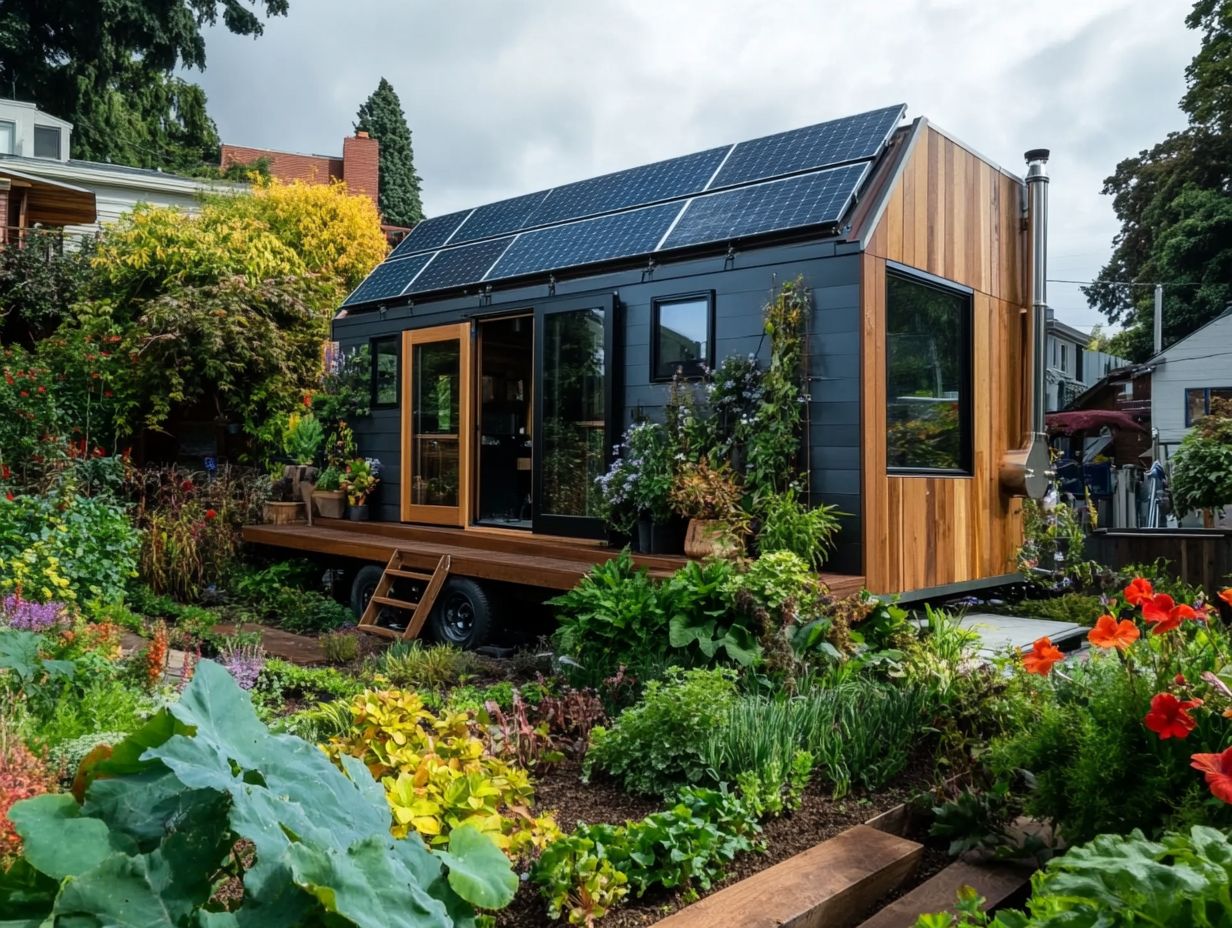
Minimizing water usage in tiny homes is vital for sustainable living. You can achieve this with greywater systems, which allow you to reuse water from sinks and showers, and water-saving taps and showerheads that dramatically cut down on your overall water consumption.
By implementing these systems, you can repurpose water for irrigation and toilet flushing, effectively reducing your reliance on freshwater. When combined with water-saving fixtures, which can reduce water flow by 30% or more, you create a comprehensive strategy for water conservation.
These methods relieve pressure on local water supplies. They also promote a culture of sustainability. As more individuals, like yourself, adopt these practices, the collective impact can lead to significant reductions in water waste, promoting healthier ecosystems and a more sustainable lifestyle.
Why Choose a Tiny House for a Greener Life?
Living in a tiny house can be an exceptionally eco-friendly choice, as it naturally fosters a waste-free lifestyle and reduces your carbon footprint. It also supports sustainable construction practices that resonate with your environmental values.
By embracing compact living, you often find yourself making significant lifestyle adjustments that prioritize sustainability. Tiny homes frequently come equipped with energy-efficient appliances, solar panels, and rainwater harvesting systems. Exploring sustainable design practices for tiny houses can further enhance these features, drastically lowering energy consumption and lessening the strain on local resources.
The limited square footage means fewer materials are required for construction, encouraging the use of reclaimed or sustainably sourced options. This shift towards minimalism prompts you to reflect on your consumption habits, leading to increased awareness of your environmental impact and promoting waste reduction.
This holistic lifestyle proves that less truly equals more. Embrace simplicity for a healthier planet!
What Are the Benefits of Living in a Tiny House?
Living in a tiny house brings you a wealth of benefits, such as significantly lower living expenses, energy savings, and the chance to embrace sustainable materials and eco-friendly practices.
By downsizing to a smaller footprint, you’ll likely see your utility bills shrink dramatically, freeing up funds for enriching experiences rather than unnecessary space. Many tiny homes are expertly designed for efficiency, featuring solar panels and rainwater harvesting systems. Additionally, incorporating the top 10 sustainable building techniques for tiny houses not only reduces your carbon footprint but also promotes a lifestyle centered around conservation.
This shift towards simplicity enhances your personal well-being and fosters a deeper connection with nature. It encourages you to adopt mindful living practices that prioritize both environmental stewardship and a richer quality of life.
Join the tiny house movement today and make a real difference!
What Are the Challenges of Building an Eco-Friendly Tiny House?
Building an eco-friendly tiny house presents a unique set of challenges. You need to source sustainable materials and ensure proper insulation. Additionally, you must adhere to local building codes while maintaining a minimal footprint.
For many builders, the pursuit of ideal resources often requires navigating a marketplace that may not fully support eco-friendly choices. This can lead to frustrations over availability and pricing. Cost implications can become significant hurdles, as green materials and energy-saving features often demand larger upfront investments, even though they promise long-term savings.
Compliance with various regulations can further complicate matters. In-depth research and potential modifications to your designs may be necessary to meet local standards. Therefore, if you’re aiming to create a sustainable home, meticulous planning is essential. For guidance on sourcing the right materials, consider exploring how to source sustainable materials for your tiny home. Use smart solutions and eco-friendly practices to overcome these challenges and realize your vision.
How Can One Incorporate Sustainable Practices into Their Daily Routine?
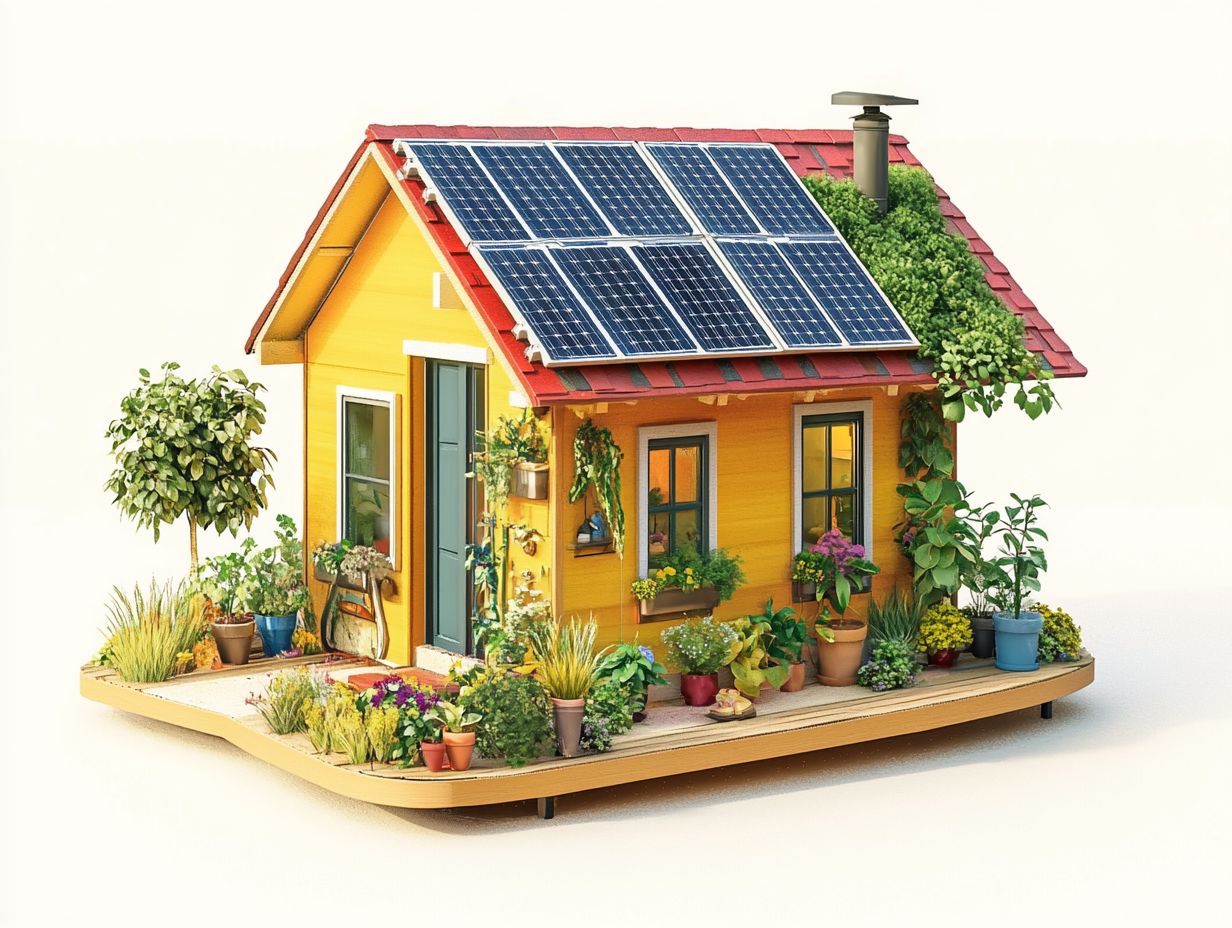
Incorporating sustainable practices into your daily routines can significantly enhance the eco-friendliness of tiny homes. This promotes a waste-free lifestyle while fostering a deeper environmental consciousness.
By adopting energy-efficient appliances, you can lower your electricity consumption and reduce your carbon footprint. Simple shifts, such as using LED light bulbs and selecting Energy Star-rated devices, can lead to substantial savings over time.
Embracing composting turning food scraps into fertilizer for your plants allows you to enrich your soil while diverting waste from landfills. Establishing a strong recycling habit is essential; it enables you to repurpose materials and minimizes resource depletion.
Practicing mindful consumption by choosing local products and avoiding single-use plastics encourages a lifestyle that respects both the environment and community resources. Don’t wait! Start incorporating these practices today for a better tomorrow.
What Are the Long-Term Savings of Living in an Eco-Friendly Tiny House?
Living in an eco-friendly tiny house can lead to substantial long-term savings, especially when it comes to reducing energy bills, trimming maintenance costs, and minimizing resource consumption.
By integrating solar panels, you can tap into renewable energy, significantly slashing your electricity expenses. Choosing energy-efficient appliances not only aids in conservation but often comes with rebates and incentives that help lower your initial investment. For those interested in eco-friendly living, designing a tiny house for sustainability can further enhance the benefits of a compact home. The compact nature of a tiny home typically results in lower property taxes, making it an attractive option for anyone seeking financial relief.
The reduced utility costs associated with tiny living like heating and cooling contribute to a more sustainable and economically savvy lifestyle. This enables you to reallocate resources toward experiences rather than excessive expenses.
What Are Some Common Misconceptions About Tiny Houses and Sustainability?
Many people mistakenly think tiny homes lack modern conveniences. They believe choosing a tiny house means sacrificing comfort for eco-friendly living.
In reality, tiny homes offer innovative solutions that balance comfort and environmental responsibility. Many of these dwellings feature energy-efficient appliances, smart home technology, and sustainable materials.
For example, solar panels power the home efficiently, and rainwater harvesting systems help conserve water. These advancements enhance your living experience while promoting a lifestyle that respects our planet.
Tiny homes are a great option for anyone seeking a cozy yet efficient living arrangement.
Frequently Asked Questions
What are 8 ways to make your tiny house eco-friendly?
1. Install solar panels: Use solar energy to lower your carbon footprint and save on energy bills.
2. Use sustainable building materials: Choose eco-friendly materials like bamboo or reclaimed wood for construction.
3. Install a rainwater collection system: Collect rainwater for watering plants or flushing toilets to reduce usage.
4. Opt for energy-efficient appliances: Look for ENERGY STAR-rated appliances to save energy and money.
5. Use LED lighting: LED bulbs consume less energy and last longer than traditional bulbs.
6. Implement proper insulation: Good insulation helps maintain temperature and reduces energy use.
7. Choose low-flow fixtures: Use low-flow toilets, showerheads, and faucets to minimize water consumption. Consider a greywater system to recycle water for irrigation.
8. Incorporate greenery: Plant trees and other plants around your tiny house for shade, energy savings, and better air quality.


